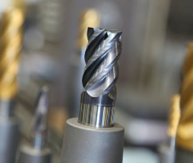
Every CNC shop wants to control costs and improve productivity. Using the most appropriate CNC machine technology and applying lean manufacturing principals are two important ways to achieve both goals. However we sometimes overlook the small things that can make a big difference, such as getting the most out of our cutting tools. Not only are the tools, themselves, costly but replacing worn tools can interrupt production, add labor costs and impact the quality of the parts being machined.
Here are 5 suggestions for prolonging the life of your cutting tools:
- Consider the materials you are machining. All metals have unique characteristics. Some are relatively easy to cut while exotic alloys, titanium and other materials are more challenging. For example, while softer materials require simple tools, other metals may not only be harder, but also generate more heat in the cutting zone, thus requiring advanced coatings, higher rake angles, increased clearance angles and wider flutes.
- Match the tooling to the application. In addition to the material being machined, you should consider the complexity of the cutting operations being performed. Among the factors to think about are geometry, hardness, sharpness and coatings. Tool supplier Sandvik Coromant provides a comprehensive guide to cutting tool types and their applications.
- Recognize the different kinds of tool wear: Flank wear is simply the result of the pressure of the cutting tool on the workpiece. Notching is damage caused by adhesion to the rake face and flank of the tool. Cratering of the rake side of the insert occurs from a chemical reaction between the material and cutting tool. Edge build-up typically happens when cutting softer materials such as copper and aluminum. These materials can adhere themselves to the cutting tool surface. Drill bits are subject to edge wear and inserts can experience edge cracks.
- Be aware of the effects of temperature: The energy used in cutting metals converts to heat. About 80% of this heat is typically transferred to the chips, which leaves 20% affecting the tool and spindle. These temperatures can be as high as 700º F and can deform both the cutting tool and the workpiece.
- Use coolant correctly. When temperatures exceed 500º F molecular changes begin to take place even in hardened steel. The nature of the material you are cutting, the spindle speed, feed-rate, complexity of cut and operations to be performed will all impact the way coolant should be applied during a machining cycle. Coolant delivery should be programmed to apply the proper pressure at various stages of an operation, either through the CNC machine controller or via a peripheral programmable variable pressure coolant system.